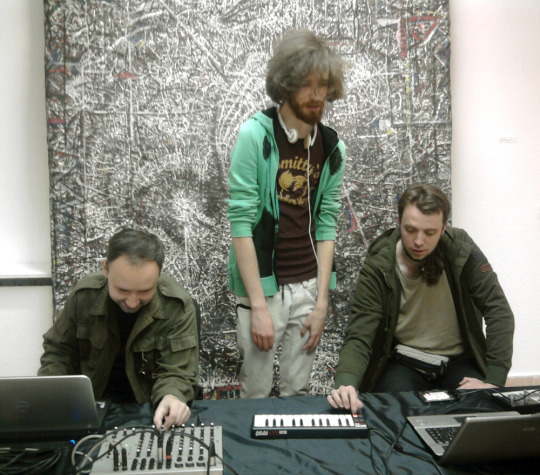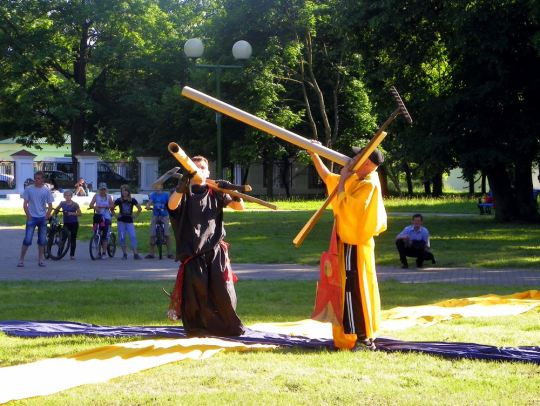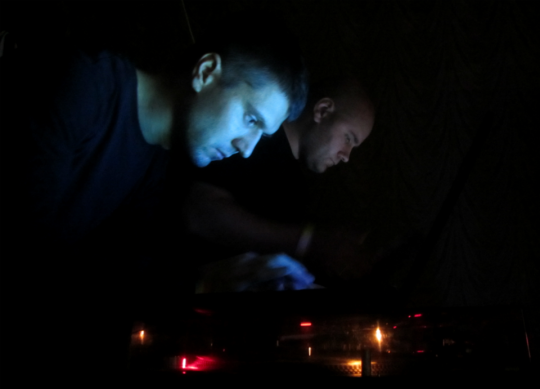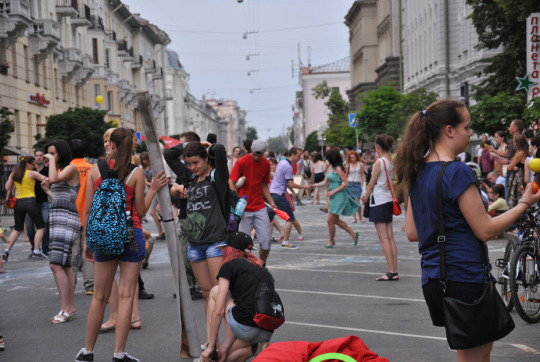2013 in Belarusian music by Pavel Niakhayeu
Published January, 2014
by Easterndaze

Pavel Niakhayeu is a Belarusian electronic musician (Pavel Ambiont, Nieviadomy Artyst) whose recent releases include Pagan & Urban (2013), Dare To Know (2014). He also runs the Force Carriers label and is a lecturer of ‘Contemporary Music Culture’ and ‘Creative Industries’ at EHU – Belarusian university in Vilnius, LT.
1. Musical highlight of the year?
2. Discovery of the year?
I feel connected to the techno and electronic scene the most, so will speak from that perspective. (For a brief overview of our electronic music please see this article – Electronic Music in Belarus – short intro)
In my opinion, 2013 was a quiet year, with less events and activities, but some notable things did happen.
There were interesting releases by Foundamental Network, Energun records, H-A-Z-E, Solanic, Byzond records, Ezhevika. Skweee labels – as well as artists releasing on multiple labels or by themselves (like Ales Tsurko or Deech). I haven’t managed to listen even half of these releases, but here’s what that I liked the most:
-
Hard techno by UVL.
-
Harmash soundtrack for ‘Der Golem’.
-
Strobe Light Visions – new electro retro-space-techno project of Uncou. The premiere gig was in october and I guess he has more than album of material now, but it’s unreleased yet except for one track on Stellar Obsession. I’m proud of this compilation released on my label because it gathers artists from several ‘waves’ of our electronica – some of them don’t live in Belarus for many years now. The youngest of the featured artists, Goawash (one part of DJ-duo Maevtika), is a very promising discovery.
Another personal discovery was Max Verbitsky – who’s making various kinds of psychedelic music for several years but mostly shares it among his friends. Here’s his haunting Bardo Thodol.
I’ve been waiting for the second release of Šuma – but they released only remix EP in 2013. I like their idea of mixing authentic Belarusian folk and current sounds – and only hope that electronica and their rock-n-roll drive (gaining full force on concerts) won’t overshadow the subtlety of folk.
Of not so electronic music, I liked the recordings of mysterious post-rockers Delay FM, but haven’t heard them live yet.
The festival that impressed me the most in 2013 was DACH festival. Run by Zmicer Yurkevich from ‘Mechanery Kultury’ performance art group and an outstanding painter Alexander Rodin, Dach is ever mutating in scale and forms, but somehow manages to temporarily join very different pieces of our cultural mosaic – art (painting, photography, performance), music (from noise to techno, avant-garde, improv, folk and rock) – and people from many unrelated communities and obscure artistic ‘sects’.

Pavel Ambiont, Radiokoala, Golova @ Dach festival, Minsk – May 2013. Photo: Olga Salakheyeva
Along with the Minsk edition in May, there were also 2 summer – in a small town Pružany and at abandoned mansion of Tadevuš Rejtan in Hrušaŭka. I played both in Minsk and Pružany – and, the second one was unexpectedly nice. Unexpectedly, because it was too freaky for a small quiet town and a beautiful state-owned museum with a friendly staff. Pure joy!

Photo: Zmicer Yurkevich & Alexander Rodin opening the Dach festival edition in Pruzany, 15.06.2013. Photo: Pavel Niakhayeu

Photo: UVL & S4DS @ Rhythm & Force, October 2013. Photo: Pavel Niakhayeu
Speaking of other gigs – S4DS, UVL, Strobe Light Visions Uncou livesets were among the best. Along with our techno-pioneers, Energun or a glitch-master I/DEX, they would fit any good international festival line-up, but for now you need to come to Belarus – and then wait for a lucky occasion to hear them playing at a party with 50-100 die-hard fans.
Underground promoters are now lucky if 150-200 people comes to a party, which means ‘negative profits’ even in a cheapest club with a cheapest soundsystem. But that’s usually not the case – most of our clubs charge quite serious money for renting their space.That’s the reason why many interesting and longest-running ‘non-commercial’ promo-groups put their activities ‘on pause’ in the recent years. And here we get to the question of the environment.
3. General situation of the year
This year has seen less underground events (and it’s not just me not going to clubs). More entertainment-friendly music – tech-house, electro-house, less adventurous ‘minimal’ or mainstream dubstepdrum-n-bass can serve as a more predictable audio-backdrop for bar-emptying fun than experimental electronica, harder techno or something that club/bar owners can’t fit into an easy-to-grasp category.
Club DJs still rarely play Belarusian electronic music (if ever). Here old-school vinyl purism meets cargo cult. Not so many Belarusian artists (Schmoltz, East Soul Person, who else?) have released on vinyl recently. And foreign music still seems sweeter for many DJs and listeners.
Similarly, local music media usually start paying attention to local artists only when those get some publicity in the West. Even non-governmental media are not always independent in their opinion making. While the government media filter out politically ‘non-loyal’ artists, the oppositional media not only scorn ‘the regime supporters’ – but often ignore those artists who choose not to express their political views through art. This leads to further segmentation of the music scene and a funny situation when musicians know almost nothing about what’s happening in other segments of our relatively small ‘underground’ scene. A good example is an article by Sergey Pukst – Belarus: uncharted territory on the musical map of Europe. It’s a brilliant analysis – but totally omitting the electronic scene that exists since the earl/mid-90’s.
Lack of media coverage is compensated by social networks, a number of niche blogs and zines (like Foundamental, Contrabass.by or Que Journal). It’s strange – but one of the most representative resources on current Belarusian music is FarFromMoscow website, run by UCLA professor David MacFadyen. Absence of TV channels broadcasting independent Belarusian music leads to launching web-TV shows like Tape Live or TECHNOVИDENИE. That’s great and we need more of this. I wonder why our ‘blacklisted’ rock-musicians banned from playing in Belarus don’t do web-streaming concerts?
The issue of political oppression is very important and the situation is too complex to reduce it to simple media-cliches. But, as one foreign journalist told me – ‘Editors, journalists and readers love the romantic idea of suppression and the heroic/artistic rebellion of a few’. That’s great that people care, but the perspective often gets a bit too narrow.
Last spring an Italian team came to Minsk for a month to make a documentary about the Belarusian underground. They’ve done an amazing job interviewing as many creative people as they could reach – musicians, theater activists, curators and writers. But again – what do we see on the poster and in the project description? Lukashenko 🙂 As if he’s the biggest star of the underground scene. One of the ugliest ‘achievements’ of his regime is that the whole country, its culture and even people who hate ‘the system’ are associated (or stigmatized) with the image of his regime and ‘the last dictatorship’ brand.
While some local artists and cultural activists (over)use this ‘last dictatorship’ tag for self-promotion, most of the electronic scene seems ‘above the political issues’ and hot topics loved by the media. Not that the musicians and DJs don’t care about the politics – they do, as much as any sentient being having to live in the absurdist reality poisoned by The Leader’s paranoid emanations and ‘genius ideas’. You could meet ravers and DJs at oppositional meetings too. But many just try to focus on music, keeping away from the toxic ideology waste. Everyone struggles everyday, so what? Make music, don’t complain. I believe that most artists would prefer if their work was appreciated for its own merit, not thanks to the image of ‘dictatorship’s victims’ or ‘culturally isolated handicapped folks who still try to do something’.
Fragmentation of the scene(s) is greatly reinforced by the economic factors. On the everyday level, the economic factors influence the scene stronger or at least more evident direct than political or legislative pressure (of course, the economy is the result of the current politics). The only quite booming or self-sustaining sectors in the country’s economy are IT and game industries and this affects creative/cultural sector in general.
For example, Wargaming, Belarusian company that created ‘World Of Tanks’ game is recruiting not just programmers, but more and more creatives of all kinds. Among them, musicians, visual artists, promoters started working on Wargaming in the recent years – and the company is highly demanding in terms of commitment, giving more financial stability, but leaving almost no time and energy for music and activism.
Many musicians – electronic and rock – are balancing on a verge of ‘quitting it all’ with the creative output. The listeners cash is a scarce resource and underground promoters can’t compete for the club-space with more financially predictable mainstream parties. If artists can’t get financial rewards for selling or playing their music in their own country, and if promoters can’t rely on profits due to low admittance and costly club rent – it can discourage even the strong ones.
But if you can’t play in a club, maybe you could play at a street festival or at illegal forest rave? Usually the ‘less-commercial’ styles are flowering at half-secret parties and raves. Forest and ruin open-air festivals did happen this year – Euthanasia, Organic family, Peyote Promo,Grave Board Clan and other groups organized several events in summer. Mirum Festival was held for the second time near the medieval castle in Mir. I’ve also heard about a free techno festival held by some young promoters for the first time – hope they’ll continue!
As for the street music, the city authorities made a couple of experiments in 2013 – several jazz concerts were held near the City-Hall (Ratuša) and one of the central streets, Karl Marx st., turned into a temporary music and entertainment space. Musicians, street performers and jugglers, film screenings – all these were permitted on weekends throughout the warm season. They still needed to obtain an approval, but the procedure was quite relaxed.

Karl Marx street, Minsk, June 2013. Photo: Lena Yurkevich.
This initiative was so unusual for Minsk that people perceived it over-optimistically, gladly forgetting that this is the only such ‘freedom reservation’ in a city which is generally hostile to street music and other ‘unauthorized street activity’.

Karl Marx street, Minsk, June 2013. Photo: Lena Yurkevich.
Especially ironic is the fact that on this very street, just several hundred meters from all the ‘authorized innocent fun’, Lukashenko’s Residence is situated where he’s working hard on making people happier. Here are some results of his legislative work in 2013:
Autumn has seen the return of ‘touring certificates’ – approvals obtained from the local authorities to organize a concert or festival (‘a mass cultural event’). These certificates were previously introduced by the President’s Decree in 2008, then cancelled in 2010, and again re-introduced in 2013 – all these contradictory decisions were explained by the same, almost cut-&-paste argumentation (‘a step to optimize and support the culture…’). Official goals: market regulation and ‘fake’ concerts prevention. True intentions: ideological and economic filtering.
Another legislative step that influenced the music scene was a requirement to install surveillance cameras in nightclubs and similar venues (not all had them yet). At least some promoters didn’t risk to make parties and concerts before they install cams, which would take time, money and lots of bureaucratic paperwork.
Visas issue is important as usual – both for Belarusian artists wanting to play abroad, and for foreign artists coming to Belarus. Not many European promoters are ready to prepare extra documents and pay extra money for the visa when inviting a Belarusian artist – that’s why many good artists never played abroad yet. Only the larger cultural institutions and festivals usually have patience and budget to invite Belarusian artists and help sorting their visa issues.
Likewise, obtaining a Belarusian visa for foreign artists is not very inspiring process, and for many years our promoters used a scheme when artists applied for a visa not in their home country, but upon arrival to Minsk airport – which lead to occasional ‘last day gig cancellations’. In 2012 this option was cancelled – foreigners could get a Belarusian visa at the airport only if there were no Belarusian embassy in their countries. Funny, but this ‘airport-visa’ option was restored in September 2013 year. The authorities promise to temporarily ease the visa-process even more – cancelling the visas for the period of The World Hockey Championship 2014.
So, welcome to Belarus, but go to a concert or a party instead of hockey 🙂
4. Personal wishes and tips for 2014?
Connect and collaborate. Don’t wait till someone (a label, producer, booking-manager, festival) comes and makes you a miracle. Move, show your art! And don’t forget to backup your files! I’ve survived a HDD crashed last august – luckily, most of the stuff was stored on another one.